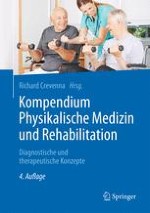2017 | OriginalPaper | Buchkapitel
26. Rehabilitation nach Schlaganfall
verfasst von : Prim. Dr. Silvia Brandstätter
Erschienen in: Kompendium Physikalische Medizin und Rehabilitation
Verlag: Springer Berlin Heidelberg
2017 | OriginalPaper | Buchkapitel
verfasst von : Prim. Dr. Silvia Brandstätter
Erschienen in: Kompendium Physikalische Medizin und Rehabilitation
Verlag: Springer Berlin Heidelberg
Print ISBN: 978-3-662-49034-1
Electronic ISBN: 978-3-662-49035-8
Copyright-Jahr: 2017
